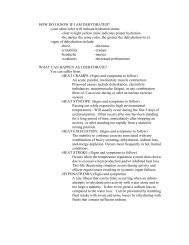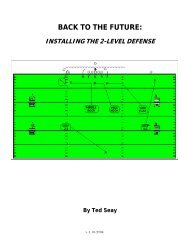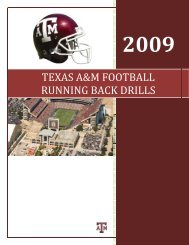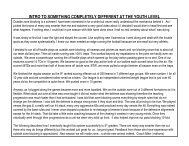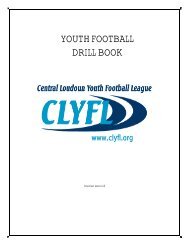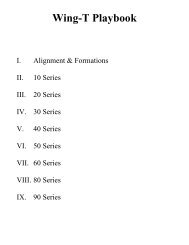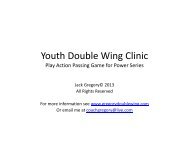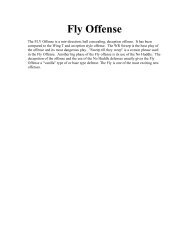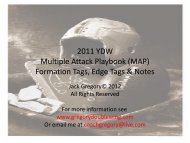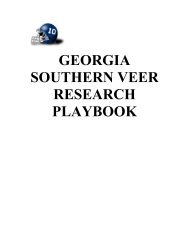BASH Zone Blocking Manual - Gregory Double Wing
BASH Zone Blocking Manual - Gregory Double Wing
BASH Zone Blocking Manual - Gregory Double Wing
Create successful ePaper yourself
Turn your PDF publications into a flip-book with our unique Google optimized e-Paper software.
ZONE BLOCKINGMANUAL1
Run <strong>Blocking</strong> TechniquesGENERAL INFORMATIONLINESPLITS--18"DEPTH--DownhandontoesoftheCenterLEFT SIDE OF LINE-Left hand downRIGHT SIDE OF LINE-Right hand downCOVERED LINEMAN-Defender head-up or on either shoulder on the line ofscrimmage in 3 or 4 point stanceUNCOVERED LINEMAN-Defender head-up or on either shoulderon the line of scrimmage in 3 or 4 point stancetoes of the Centertoes of the Center00000000 0018" 18" 18" 18"STEP CHARTBAABCDELA. Drive Step-6 inch directional step toward Aiming Point.Usually used for Base block.B. Lead Step-6 inch directional step toward Aiming Point.Used for an inside <strong>Zone</strong>, Down or Chip blockC. Slide Step-6 inch directional step toward Aiming Point.Used for Outside <strong>Zone</strong> <strong>Blocking</strong> when covered with a HEAD UP defender.D. Drop Step-6 inch directional step toward Aiming Point.Used for Outside <strong>Zone</strong> <strong>Blocking</strong> when covered andfacing an OUTSIDE SHADE defender.E. Bucket Step-6 inch directional step toward Aiming Point. Usedfor Outside <strong>Zone</strong><strong>Blocking</strong> when uncovered.EDC2
Run <strong>Blocking</strong> TechniquesI. BASE BlockThe base block is the heart of any blocking scheme and the most important to master.This technique will be used by linemen MOSTLY on our Inside <strong>Zone</strong> (Base) playwhen they are covered and their inside teammate is also covered. It is important to notethat our linemen will have the option of blocking the defender any way the defenderwishes to go. The most important aspect is to get movement upfield, laterally, or bothand to STAY ENGAGED(Be a part of the Tackle) until the play is over. In our offensethe BASE call means that the lineman will not be involved in a combination or <strong>Zone</strong>block but, instead, he will be working alone.A. Aiming PointOn each of our blocks, the linemen will be given an aiming point. The linemanmust get his head gear to that aiming point and fight to keep it there through the executionof his block. The aiming point for the Base block is;00APThe Sternum or point between the numbers of the defender.All linemen will keep their shoulders parallel to the path of the ball carrier.This will prevent linebacker run throughs by allowing the linemen to see the defensivemovement.B. Approach (Seek)Always explode off the line of scrimmage on the correct snap count. This isaccomplished by knowing you responsibilities and ALWAYS taking the correct initialstep. Your initial step in a Base block will be with the foot nearest the defender you areblocking. After this step you must roll off the takeoff foot aggressively and with yourhead up. By keeping your head up and your back flat, you will better be able to get underthedefender‘spads. Aimthe“nose”ofyourhelmet(crosshairs)fortheproperaimingpoint. This can only be accomplished with your HEAD AND EYES UP.“A man can’t hit what his eyes can‘t see.”3
C. Contact (Destroy)Throw your arms back on your first step and POP hands into aiming pointwith as much force as possible. First contact must be with the HANDS followed by the“nose” of the helmet in order to maintain control and contact with the defender. Thelineman‘s hands will make contact with the defender at the Aiming Point (Sternum) withthe thumbs up. A lifting action (Bench Press) will be utilized to allow the lineman to rollthe hips into the defender(LIFT HIM OUT OF HIS SHOES). This hip roll allows thelineman to use the strong leg muscles and to maintain the Power Angles. To finish theblock, the lineman will arch the back and “climb the ladder” while driving the feet.Keep a wide base with your feet and take SHORT CHOPPY POWER STEPS to maintaincontact.II. Inside <strong>Zone</strong> Principles(Base)Our Inside <strong>Zone</strong> blocking principle requires linemen to block a particularman first and to zone if Uncovered. The purpose is to stop penetration, create movementon the first level, and seal off the playside or filling linebacker on the second level.All <strong>Zone</strong> blocks begin as an inside-out double-team. As the linemen begin to get movement,either the outside or the inside lineman will gain control over the down defenderallowing the other lineman to come off the block to the second level linebacker. WEMUST get movement on the first level before sliding to the second level.A. Uncovered Lineman:00AP00 Play DirectionAIMING POINT-Inside Number of first down defender to the playsideTake a slide step and catch up with your covered teammate as you READ the nearKnee of the down lineman on him. As you work through your playside gap, if the Kneecomestowardyou,blockhisINSIDEnumber&fithimslidinginthedirectionheisgoing. (eyeball LB in case he comes inside).If the Knee doesn’t come towards you, work up on LB. You have only two options andboth depend on reading the defender‘s reaction:1. Knee goes away.(Diagram 1)a. Try to get outside hand on the hip of the downlineman while moving to the linebacker.b. Adjust your path to pick up the linebacker.c. Engage the linebacker and STAY ON THEBLOCK UNTILTHE WHISTLE.4
2. Knee comes to you.(Diagram 2)a. Continue to work to your aiming point on thedown lineman.b. Fight to gain control of the down lineman and push the out-side blocker off of the Down Linemanc. KEEPYOUR FEET MOVINGd. Engage the Down lineman and STAY ON THEBLOCK UNTILTHE WHISTLE.LBTLBTDiagram1Diagram2B. Covered lineman00 APAiming Point isOutside Number00 Play DirectionTake a lead step with your outside foot while eyeballing the outsidenumber of the defender. Throw your second step through the crotch of the DownLineman. You must think man block and only go to the LB when pushed off theblock by your teammate You have only two options and both depend on reading thedefender’s reaction:1. Defensive lineman fights to your playside gap(Diagram 1)a. Maintain contact with the down lineman and workto your aiming point.b. Engage the down lineman and STAY ON THEBLOCK UNTILTHE WHISTLE.2. Defensive lineman goes to your inside gap(Diagram 2)a. Extend inside arm on the down lineman.b. Push off the down lineman while working to thesecond level linebacker.c. Engage the linebacker and STAY ON THEBLOCK UNTILTHE WHISTLE.5
INSIDE ZONEBLOCKING RULESWhen blocking inside zone, there are THREE question you must answer;1) Am I Playside or Backside?2) Am I covered or uncovered?3) Is my inside team mate covered?A. PLAYSIDE (Includes Center)1. Covered (Inside to Outside Shoulder on LOS)a. Lineman to your inside is Coveredrule:BASE BLOCK MAN ONBN T EPlay Directionb. Lineman to your inside is UncoveredBN T Erule:POWERZONEw/INSIDELMPlay Direction2. Uncovered (Inside to outside shoulder off the LOS)rule:POWER ZONE w/ OUTSIDE LMBN T EPlay Direction6
B. BACKSIDE1. GUARDa. CENTER COVERED b. CENTER UNCOVEREDrule:POWER ZONE w/ CENTERTBNrule:REACH PLAYSIDE GAP TO LBE TBN2. TACKLEa. EMOL is on You b. EMOL is outside of yourule:REACH PLAYSIDE GAP TO LBBE T Nrule:1st DOWN LM HEAD UP TOOUTSIDE OF GUARDETBN3. TIGHT ENDa. Tackle is Covered b. Tackle is Uncoveredrule:POWER ZONE w/ TACKLEB BE T Nrule:REACH TO LBBE TBNPLAY DIRECTION FOR ALL EXAMPLES7
III. Combination Blocks (Diagram 3)The following calls can be made to help linemen determine who theyare working in combination with.A. “ACE”(G-Covered, C-Uncovered)Combination block between the Center and the Guard usedto handle a 0 technique to a 3 technique playside. Call will be madeinitially by the Guard. The center will add a “RAM” call if he combos withthe right Guard or a “LION” call if he combos with the left Guard.B. “DUECE”(T-Covered, G-Uncovered)CombinationblockbetweentheGuardandtheTackleinordertohandle a down lineman and a linebacker. Tackle will make the call if theGuard is uncovered and available to help the Tackle.C. “TREY” (Y-Covered, T-Uncovered)Combination block between the Tackle and the Tight Endin order to handle the defensive end and a linebacker or strong safety. Usually called by Tight End on playside versus a 7 technique.D. “BASE”(Covered Lineman w/ inside Teammate also Covered)Call made by any lineman when he is covered and his insideteammate is also covered. Inside <strong>Zone</strong> or Base play will most often carry thiscall.E. “SLIP” or “SLIDE”Backside call made by lineman not in combination. Tells him toblock his backside rule.Line Calls for “Red Base” (Inside <strong>Zone</strong>)Diagram 3ETBNBTEBBE T TBE“Base”52“Lion”“Duece”“Base”43“Slip”“Slip”“Ram”“Trey”BEBTBTEBETBNBTE44“Slip”“Ram”“Trey”“Slip”52 Over“Deuce”“Ram”“Base”8
TECHNIQUES AND PRE-SNAP READSBy learning the defensive line techniques, offensive linemen can get a verygood idea who they will end up blocking on inside zone plays. If the Offensive linemancan master the 10-50-90 rule, he will make himself a much more effectiveblocker and will make us a much better team.8DEFENSIVE TECHNIQUES9 67 54 4I 3 2 1 0 123 4I45 76981. INSIDE SHADE ON GUARD 5. OUTSIDE SHADE ON TACKLE2. HEAD UP-ON GUARD 6. HEAD UP-ON TE3. OUTSIDE SHADE ON GUARD 7. INSIDE SHADE ON TE4I. INSIDE SHADE ON TACKLE 8. ONE MAN OUTSIDE OF TE4. HEAD UP-ON TACKLE 9. OUTSIDE SHADE OF TE**ALL EVEN NUMBERS DESIGNATE A HEAD-UP ALIGNMENT10-50-90 RULEIF THE COVERED LINEMAN HAS AN OUTSIDE SHADE;-COVERED LINEMAN HAS A 90% PROBABILITY THAT HE WILLSTAY ON THAT MAN.-UNCOVERED LINEMAN HAS A 10% PROBABILITY THAT HE WILLBLOCK THE DEFENSIVE LINEMAN.IF THE COVERED LINEMAN HAS A HEAD-UP DEFENDER;-COVERED LINEMAN HAS A 50% PROBABILITY THAT HE WILLSTAY ON THAT MAN.-UNCOVERED LINEMAN HAS A 50% PROBABILITY THAT HE WILLBLOCK THE DEFENSIVE LINEMAN.IF THE COVERED LINEMAN HAS AN INSIDE SHADE;105090TT50-COVERED LINEMAN HAS A 10% PROBABILITY THAT HE WILLSTAY ON THAT MAN.-UNCOVERED LINEMAN HAS A 90% PROBABILITY THAT HE WILLBLOCK THE DEFENSIVE LINEMAN.T90 109
IV. Outside <strong>Zone</strong> Principles(Stretch)change.The same rules as Inside <strong>Zone</strong> but the aiming points and steps willA. Uncovered BlockerUse a “Bucket Step”, and crossover to Piggyback your coveredteammate.(aim for the shoulder pad of your teammate) Uncovered blocker will stayon a down lineman on your covered teammate. FORCED THE SWITCH. Don’tblock LB unless he is even with your inside shoulder and threatening the gap.B. Covered BlockerUse a “Slide Step” to the DLM’s outside shoulder when thedefender is head up. Use a “Drop Step” to the DLM’s outside shoulder when thedefender is shaded to the outside. Run through the playside shoulder and get on theLBer.ALWAYS BECOMEPART OF THETACKLE!!!stay on your block10
V. Counter Principles and RulesPlay can be run as a “Counter” with the backside Tackle leadingthrough the hole, or as a “Counter Lead” with the first backside back leadingthrough the hole. The same concept as Inside <strong>Zone</strong> except that the rules are opposite.You must still answer the same questions;1) Am I Playside or Backside?2) Am I covered or uncovered?3) Is my inside teamate covered?A. PLAYSIDE LINEMEN (G-T-TE)1. Covereda. LinemantoyourinsideisCoveredRULE: Work zone with your inside teammate to the backside LBb. Lineman to your inside is UncoveredRULE: Work zone with your outside teammate to the backside LB2. Uncovereda. LinemantoyourinsideisCoveredRULE: Work Track <strong>Zone</strong> with your inside teammate to the backside LBb. Lineman to your inside is uncoveredRULE: Work Track <strong>Zone</strong> from inside gap to Backside LB-build a wall.B. CENTER1st man on the LOS to the offsideC. OFFSIDE GUARDPull through the football. There is no read---KICK OUT the End Manon the Line(EMOL)D. OFFSIDE TACKLECOUNTER: Pull 1 yard deeper and on the hip of the Offside Guard.Dip upfield directly off of the playside double-team and look over your inside shoulderfor the playside LB. DON’T SLOW DOWN!! If the LB runs through, Trap him.LEAD: #2 Down lineman to your side11
ETCOUNTER & LEADB B SSB B SSN T E E T N T ECounter52LeadEB B BT N TEEB B BT N TECounterB B BE N TE53LeadB B BE N T ECounterB B BE TTEB43B B BE TTLeadEBCounterBB B BE N EB44BB B BE N ELeadBCounter 33Lead12
VI. Man <strong>Blocking</strong>Man blocking requires that the lineman memorize a set of RULES for eachman blocking play. He must also know that those terms need to be followedin the order they occur. The following example should help you to understandhow these terms work.EXAMPLE:LINMAN’S RULE: “ON-OVER-TRACK ZONE”ON-If you are COVERED, base block man onT**If there is no one on you, move to next stepOVER-If there is a LB over you,baseblockhimTB**Ifthereisnooneonoroveryou,movetonextstepTRACK ZONE: Track<strong>Zone</strong>isanoutside-inzoneblockwhichtakes the blocker to the backside LBBT13
LINE TERMSACE (G-Covered, C-Uncovered)CombinationblockbetweentheCenterandtheGuardusedtohandlea0to3technique lineman on the playside. Initial call will be made by the Guard. The Centerwilladda“RAM”callifhecomboswiththerightGuard,ora“LION”callifhecomboswith the left Guard.(see page 20)LIONCall associated with ACE. LION will tell the Left Guard that he will be workingin tandem with the Center on an ACE zone block. Call will be made by the Center orGuard.(see page 20)RAMCall associated with ACE. RAM will tell the Right Guard that he will be workingin tandem with the Center on an ACE zone block. Call will be made by the Centeror Guard.(see page 20)DUECE (T-Covered, G-Uncovered)Combination block between the Guard and the Tackle in order to handle a downlineman and a linebacker. Tackle will make the call if the Guard is uncovered and availableto help the Tackle.(see page 20)TREY (Y-Covered, T-Uncovered)Combination block between the Tackle and the Tight End in order to handle thedefensive end and a linebacker or strong safety. Usually called by the Tight End onplayside versus a 7 technique.(see page 20)BASE (Covered Lineman w/ inside Teammate also Covered)Called made by any lineman when he has a defender shaded to his outside andthe play is going inside. Inside zone or Base play will most often carry this call.BASE is also our call for the inside zone play.(see page 20)COUNTER<strong>Blocking</strong> scheme in which both the backside Guard and the backside Tackle pullto the called side. The Guard will trap block the first defender to show and the Tacklewill lead on the first linebacker. All playside linemen will block <strong>Zone</strong> Counterrules.(see page 23) . COUNTER is not only the blocking scheme, it is also the playname.14
TAIL (Tackle Lead)Backside Tackle leads through the playside hole to a linebacker. This call willusually occur on a Wrap Play when the Guard is covered.GULL (Guard Lead)Backside Guard leads through the playside hole to a linebacker. This call willusually occur on a Wrap Play when the Guard is uncovered.GUT (Guard Trap)Backside Guard traps the first down lineman past the PS guard.GUT is not only the blocking scheme, it is also the play name. If the play call is precededby a letter, it will designate that someone other than the H back will carry the ball, itwill not change the blocking. Ex; Q GUT, A GUT, Z GUT, etc.GUS (G-Block)Playside Guard will pull and kick out the EMOL(end man on line)LOGBlock executed by a pulling lineman to seal the EMOL(end man on line) to theinside.COVEREDAlignment of a defensive linemen head-up or on either shoulder of the Offensivelineman on the Line of Scrimmage. Defender is usually in a 3 or 4 point stance.(seepages 18-19)UNCOVEREDIndicates the same as COVERED except the defender is off the Line of Scrimmageby 1 or more yards. Defender is usually standing up.(see pages 18-19)TRACK ZONECounter and Lead <strong>Zone</strong> blocking AWAY from the play side. Same covered anduncovered rules are applied, but the uncovered man helps the next teammate away fromplayside. This is an outside-in <strong>Zone</strong>. (see page 23)SLIPBackside zone blocking technique. Tells the backside linemen they are blockingtheir backside rules. (see page 19)15
LEADCounter blocking scheme in which the Backside back will lead through holeon linebacker instead of the backside Tackle. Backside Tackle blocks the #2 linemanto the Backside. (see page 24)ONBase block on a down defender. Offensive lineman is covered.OVERBase block on a LB who is playing off ball from inside to outside shoulder ofthe offensive lineman.FREDFold block in which the outside man blocks down and the inside man folds tothe outside. The down blocker always goes first.WILMAFold block in which the inside man blocks out and the outside man folds to theinside. The out blocker always goes first.REACHBlockonadefensivelinemanwhoisshadedtoyourplayside. Adroporbucketstep is used depending on how far the defender is shaded. OLM should attempt toREACH the playside shoulder of the defender and maintain contact.16




